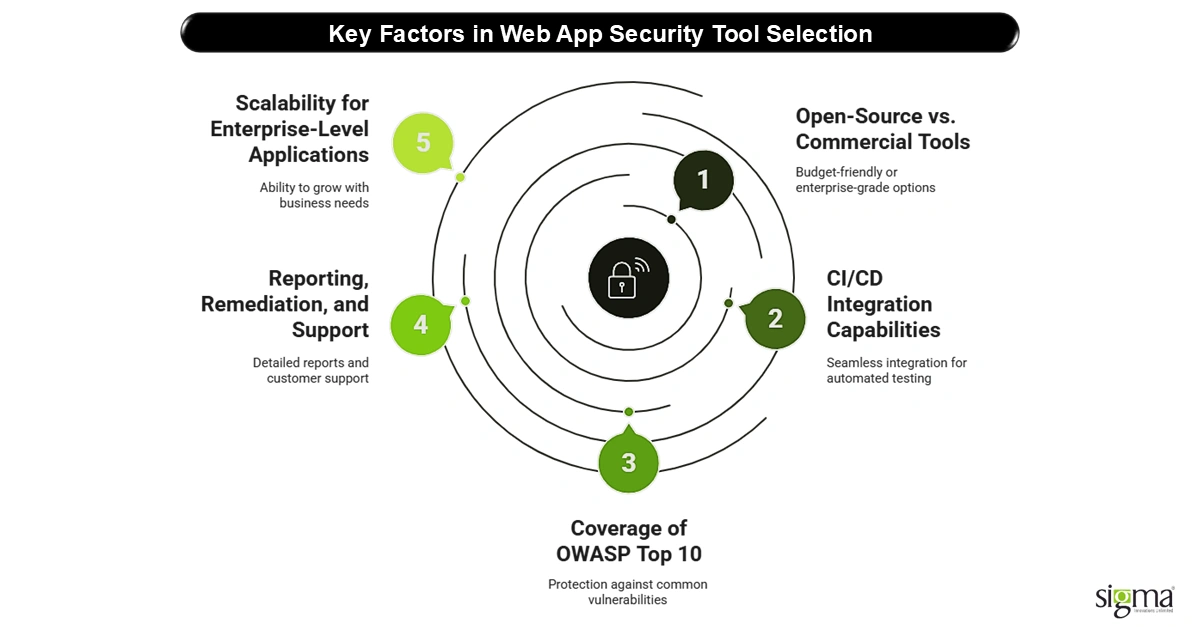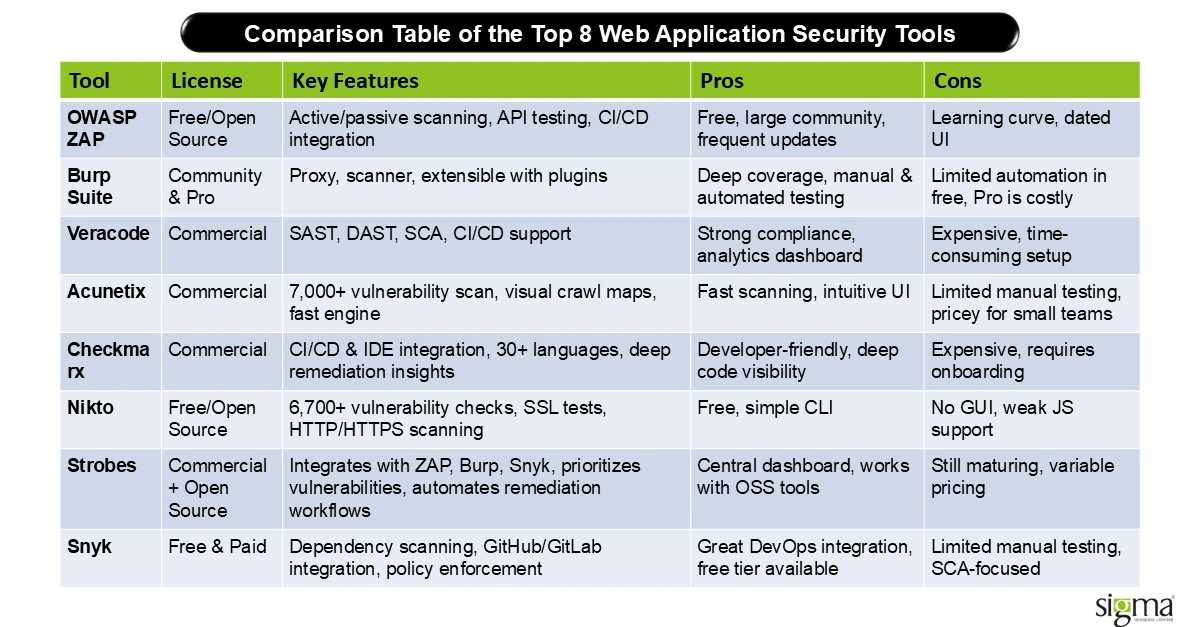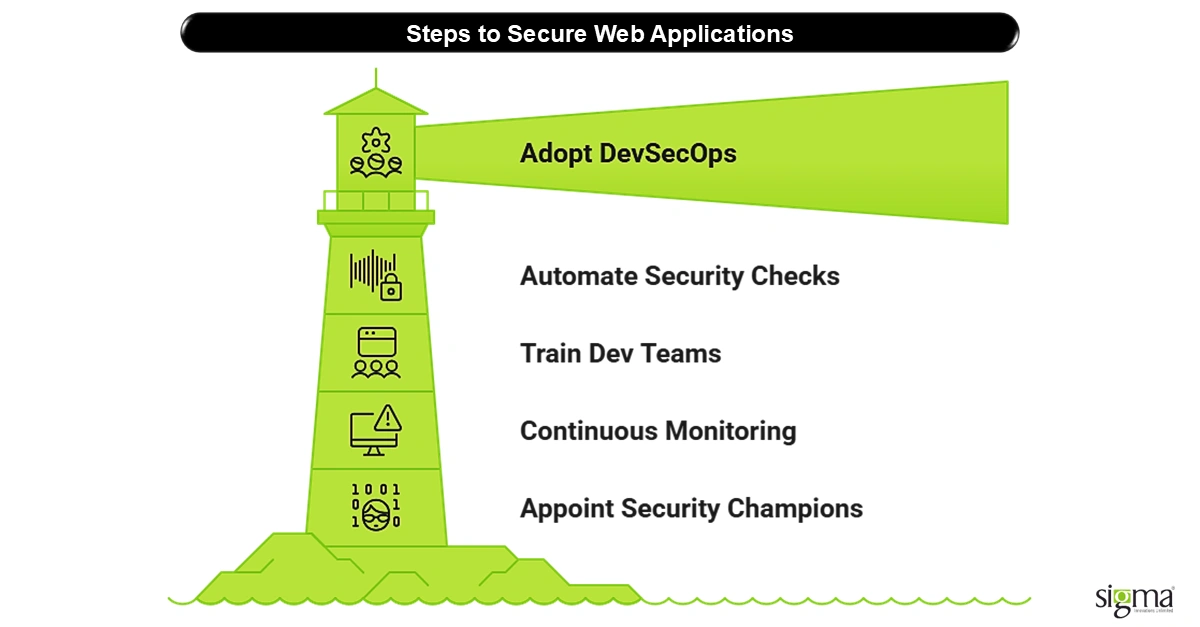Top 8 Security Testing Tools for Web Applications

Web application security has moved beyond a luxury to a fundamental necessity in our digital age. If you’re running an online business, especially in the eCommerce space, your website is more than a storefront — it’s your front line. With all the customer data, payment info, and business logic flowing through web apps, it’s a prime target for cyber threats.
Modern websites are more complex than ever. Thanks to flexible frameworks, powerful APIs, and third-party integrations, we can build feature-rich platforms faster. But here’s the flip side: every integration and added feature increases the attack surface. That’s where security testing tools step in — they’re like watchdogs sniffing out vulnerabilities before the bad guys do.
For online businesses running on Adobe Commerce (Magento), Magento Open Source, or Shopify, there’s no room for slip-ups. The same goes for those relying on WooCommerce and BigCommerce — a single security flaw can shatter customer trust and damage your brand.
Whether you’re managing a small store or scaling operations, integrating the right security testing tools in your development process is key to a solid web application assessment.
In this blog, we’ll explore 8 powerful security testing tools that have earned their stripes through smart features, strong community backing, and relevance in today’s threat landscape — including a few free application security testing tools. Let’s lock things down the smart way.
Why Web Application Security Testing is Crucial Today
Let’s cut to the chase — cyber threats are getting smarter, faster, and nastier. From SQL injections that poke holes in your database to Cross-Site Scripting (XSS) and Remote Code Execution (RCE) attacks that let hackers take over parts of your system, the danger is real and growing. And for businesses using platforms like Adobe Commerce (Magento), Magento Open Source, Shopify, BigCommerce, and WooCommerce, even one vulnerability can spell disaster.
Today’s digital platforms are prime targets, especially in eCommerce, where sensitive user data and payment information are at stake. A single slip — say, a missed validation or a third-party plugin gone rogue — can open the door to Cross-Site Request Forgery (CSRF) attacks or worse. That’s why integrating powerful security testing tools into your development pipeline is no longer optional.
Then there’s the compliance angle. If your application handles customer payments, stores personal data, or operates across borders, you’re on the hook for regulations like PCI-DSS, SOC 2, and GDPR. Falling short on any of these can lead to steep fines, lawsuits, and a PR nightmare. Security testing helps ensure your business meets these requirements, keeps auditors happy, and protects customer trust.
Let’s talk about money. The average cost of a data breach in the U.S.? Over $9 million in 2024. That’s not just damage control — that’s lost revenue, downtime, and long-term brand damage. For eCommerce sites using Adobe Commerce (Magento), Magento Open Source, Shopify, BigCommerce, and WooCommerce, that’s game over.
The solution? Build smarter from the start. Enter DevSecOps and shift-left testing — industry buzzwords that actually mean something. By baking security testing tools into your CI/CD pipeline early on, you catch issues before they grow fangs. Think of it like checking your car brakes before you hit the freeway — it just makes sense.
With the growing focus on application security posture management, it’s time to take your testing game seriously. And don’t worry — there are some incredible (and even free) application security testing tools out there to help.
Evaluation Criteria for Choosing a Web App Security Tool
Picking the right security testing tools for your web apps is like locking your house with a smart, secure deadbolt — you want something strong, reliable, and that works with your setup. Whether you’re running the business on Adobe Commerce (Magento), Magento open source solutions, Shopify, BigCommerce, or WooCommerce, the right tool can keep you ahead of the bad guys.
Here are the key factors to consider:

Open-Source vs. Commercial Tools
- Open-source tools are great if you’re on a budget, need flexibility, or want community support. Many powerful free application security testing tools fall under this category.
- Commercial tools offer dedicated support, enterprise-grade features, and better reporting — ideal for teams that need speed, scalability, and compliance coverage.
CI/CD Integration Capabilities
- A good security tool should integrate smoothly with your CI/CD pipeline, enabling shift-left testing without slowing down development.
- Automated scans during code check-ins or deployments are crucial for teams embracing DevSecOps practices.
Coverage of OWASP Top 10
- Your tool must detect vulnerabilities listed in the OWASP Top 10, such as SQL Injection, XSS, and insecure deserialization.
- This ensures protection across platforms like WooCommerce, BigCommerce, and modern API-based systems.
Reporting, Remediation, and Support
- Look for tools that don’t just find issues but explain how to fix them.
- Features like detailed reporting, remediation guidance, and responsive customer support are game-changers — especially for complex web application assessments.
Scalability for Enterprise-Level Applications
- Can the tool grow with your business?
- If you’re managing multiple stores or applications — common in large eCommerce operations — the tool should support application security posture management at scale.
In short, go for tools that fit your workflow, meet your compliance goals, and are ready to scale as you grow.
Top 8 Web Application Security Testing Tools in 2025
Picking the right security testing tools for your web apps is like locking your house with a smart, secure deadbolt — you want something strong, reliable, and compatible with your setup. Whether you’re running your business on Adobe Commerce (Magento), Magento Open Source, Shopify, BigCommerce, or WooCommerce, the right tool can keep you ahead of cyber threats.
Here are the key factors to consider:

OWASP ZAP (Free/Open Source)
Overview: ZAP (Zed Attack Proxy) is one of the most widely used free application security testing tools, maintained by the OWASP Foundation.
Key Features:
- Active and passive scanning
- API security testing
- Built-in spidering and fuzzing tools
- CI/CD integrations
Ideal Use Case: Perfect for small dev teams or businesses just starting their web application assessment journey.
Pros:
- Free and open source
- Large community support
- Frequent updates
Cons:
- Learning curve for beginners
- UI feels dated
Why It’s Relevant: Ideal for those offering Magento open source solutions or Shopify development services who want reliable, no-cost testing baked into their pipelines.
Burp Suite (Community & Pro)
Overview: Burp Suite is a powerhouse in web app security testing. It’s the go-to tool for ethical hackers and pentesters.
Key Features:
- Intercepting proxy for traffic inspection
- Scanner for common and advanced web flaws
- Extensible with BApps (plugins)
Ideal Use Case: Great for security teams testing eCommerce apps with complex session flows or APIs.
Pros:
- Deep vulnerability coverage
- Supports manual and automated testing
Cons:
- The community version lacks automation
- The Pro version is pricey
Why It’s Relevant: For application security posture management in BigCommerce development services or custom-built tools, Burp is a solid investment.
Veracode (Commercial)
Overview: Veracode is a cloud-based platform offering static (SAST), dynamic (DAST), and software composition analysis (SCA).
Key Features:
- Seamless CI/CD integration
- Scans for OWASP Top 10 and beyond
- Comprehensive reports with fix recommendations
Ideal Use Case: Enterprises with large-scale development across eCommerce platforms.
Pros:
- Strong compliance support (PCI-DSS, SOC 2, etc.)
- Rich analytics dashboard
Cons:
- High licensing cost
- Initial setup takes time
Why It’s Relevant: Veracode’s scalability makes it ideal for businesses offering eCommerce Development Services at an enterprise scale.
Acunetix (Commercial)
Overview: Acunetix is a powerful automated web scanner designed to discover vulnerabilities fast.
Key Features:
- Scans for 7,000+ vulnerabilities
- Detects OWASP Top 10, RCEs, SQLi, XSS, etc.
- Visual crawl maps
Ideal Use Case: Mid-to-large businesses wanting quick, automated scans on client storefronts or internal dashboards.
Pros:
- Fast scanning engine
- Intuitive UI
Cons:
- Limited manual testing
- Costly for small teams
Why It’s Relevant: A great fit for Shopify development services and WooCommerce development services needing rapid, reliable scans.
Checkmarx (Commercial)
Overview: Checkmarx focuses on secure code from the start with powerful static analysis.
Key Features:
- CI/CD and IDE integration
- Support for 30+ programming languages
- In-depth remediation insights
Ideal Use Case: Developers working on proprietary apps with logic or embedded payment systems.
Pros:
- Developer-friendly
- Deep code visibility
Cons:
- Requires onboarding time
- Expensive for smaller teams
Why It’s Relevant: Checkmarx is perfect for DevSecOps teams building secure platforms from the ground up in Adobe Commerce (Magento) services or custom lending systems.
Nikto (Free/Open Source)
Overview: Nikto is a fast, lightweight, command-line tool for scanning web servers for misconfigurations and common issues.
Key Features:
- 6,700+ vulnerability checks
- SSL cert testing
- Fast scanning on HTTP/HTTPS
Ideal Use Case: Tech-savvy teams who want quick insights on server-level issues.
Pros:
- Totally free
- Simple to run on any system
Cons:
- No GUI
- Doesn’t handle JavaScript-heavy apps well
Why It’s Relevant: Useful for teams supporting Magento open source solutions who want fast validation before pushing updates live.
Strobes (Commercial with Open Source Integrations)
Overview: Strobes is a modern application security posture management tool that aggregates vulnerabilities from other tools into one platform.
Key Features:
- Integrates with ZAP, Burp, Snyk, etc.
- Risk-based vulnerability prioritization
- Automation for remediation workflows
Ideal Use Case: Security leads who need visibility across multiple tools and teams.
Pros:
- Centralized dashboard
- Works well with open-source scanners
Cons:
- Still maturing
- Pricing depends on usage
Why It’s Relevant: Great for agencies delivering eCommerce Development Services at scale and needing one pane of glass to manage risk.
Snyk (Free & Paid)
Overview: Snyk focuses on securing open-source dependencies and containerized applications.
Key Features:
- Real-time dependency scanning
- GitHub/GitLab integration
- Policy enforcement across teams
Ideal Use Case: Developers using Node.js, Python, or other popular stacks in cloud-native setups.
Pros:
- Excellent DevOps integration
- Free tier available
Cons:
- Limited manual testing
- Focused more on SCA than DAST
Why It’s Relevant: Snyk is ideal for Shopify development services, WooCommerce development services, or any microservice-heavy setup using open-source packages.
Honorable Mentions
Here are a few other security testing tools in software testing worth checking out:
- Netsparker – Great for automation and DAST testing
- SonarQube – Focuses on code quality and SAST
- QARK – Android-focused, useful for mobile-heavy platforms
Which tool is the best?
The “best” web application security tool depends on the specific context and the objective an enterprise is seeking to achieve. OWASP ZAP and Burp Suite are strong contenders due to their popularity, comprehensive features, and open-source nature. Some of the most widely used paid tools in this space include Acunetix (for automated vulnerability scanning) and Netsparker (for accurate and automated web application vulnerability detection).
Best Practices for Integrating Security Testing in Development

Given the potential for substantial financial damage and the erosion of customer trust caused by bugs in today’s eCommerce space, security testing must be treated as a critical necessity, not a mere checkbox. It has to be part of how you build, test, and deploy software—every step of the way.
Let’s break down some real-world best practices that can help online businesses—especially those using Adobe Commerce (Magento) services, Magento Open Source solutions, Shopify development services, WooCommerce development services, or BigCommerce development services—build secure web applications from the ground up.
Adopt DevSecOps From Day One
Think of DevSecOps as the seatbelt for your entire development car. It makes security everyone’s job, not just the security team’s. DevSecOps integrates security testing tools directly into the development workflow—so vulnerabilities are caught early, not after launch.
Benefits:
- Detect vulnerabilities faster
- Reduce the time and cost of fixes
- Improve team collaboration
Automate Security Checks in Your CI/CD Pipeline
Manual testing is important, but let’s face it—it doesn’t scale. When you embed security checks into your CI/CD pipeline, you’re baking in security from the start. This approach makes web application assessment part of your daily build process.
What to automate:
- Static code analysis (SAST)
- Dynamic scans (DAST)
- Dependency checks for third-party libraries
Whether you’re offering WooCommerce development services or running enterprise applications, automation ensures your builds are clean before going live.
Train Dev Teams on Secure Coding Practices
Your developers are your first line of defense. Training them to avoid common mistakes like SQL injection or Cross-Site Scripting (XSS) goes a long way.
Quick wins:
- Conduct quarterly secure coding workshops
- Share OWASP Top 10 vulnerabilities
- Use pair programming for high-risk modules
This is especially vital for teams working on Magento Open Source solutions and Shopify development services, where extensibility and plugins can introduce new risks.
Continuous Monitoring > One-Time Audits
Security isn’t a one-and-done thing. Just like your store gets new features or updates, new threats emerge constantly. Using security testing tools for ongoing application security posture management helps you stay ahead.
Tip: Use tools like Snyk or Veracode to scan for vulnerabilities in real-time and alert teams proactively.
Appoint Security Champions in Dev Squads
Every dev team should have a go-to “security person.” These champions bridge the gap between developers and security experts, help spread awareness, and catch risky code early.
Responsibilities of a Security Champion:
- Review code for vulnerabilities
- Guide junior developers
- Stay updated with new threats and free application security testing tools
By embedding security early, training your team, and using the right security testing tools consistently, your web apps become safer by design—not just by audit.
Whether you’re building an online store with Adobe Commerce (Magento) or scaling with BigCommerce, these practices are non-negotiable in today’s digital economy.
Building Secure Web Applications with Sigma Infosolutions
At Sigma Infosolutions, we prioritize security from the ground up. Our team specializes in building secure, high-performance web applications tailored for complex eCommerce platforms like Adobe Commerce (Magento), Shopify, WooCommerce, and BigCommerce. Security is embedded at every development stage—right from planning to deployment.
We leverage industry-leading tools and implement DevSecOps workflows with automated scans and real-time alerts to detect vulnerabilities early. Our solutions are compliance-ready, meeting PCI-DSS, SOC 2, and GDPR standards. With a security-first mindset and deep eCommerce expertise, Sigma helps you stay ahead of risks and protect your digital storefront.
Don’t Just Build Fast—Build Secure
If your web application isn’t secure, you’re leaving the door wide open for attackers. That’s why security testing tools have become a must-have in the toolbox of any serious eCommerce business.
From catching vulnerabilities like SQL injection or cross-site scripting (XSS) to ensuring your site aligns with PCI-DSS or GDPR, these tools act as your first line of defense. But remember—there’s no one-size-fits-all solution. The right tool depends on your tech stack, team size, compliance needs, and future growth plans.
Our final tip? Don’t rely solely on tools. The best results come from a solid mix of:
- Proven security testing tools
- Strong, secure coding practices
- Automated CI/CD checks
- And yes—expert guidance that understands your industry
Whether you’re using Adobe Commerce (Magento), Magento Open Source, Shopify, BigCommerce, or WooCommerce platforms, your application’s security should never be an afterthought.
Ready to find out how secure your web app really is? Get in touch with Sigma Infosolutions for a no-obligation secure application assessment. Let’s work together to lock down your digital future with smart, scalable eCommerce Development Services.




